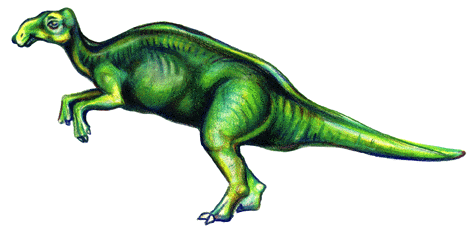


If it walks like a duck; has a beak like a duck; webbed feet like a duck; and a pelvis like a duck; it's not necessarily a duck; it could be a hadrosaurid. The "duckbilled dinosaurs" were common in the Upper Cretaceous of Europe, Asia, and North America. They were close relatives and possibly descendants of the earlier iguanodontid dinosaurs. From fossil skin impressions we know that hadrosaurid hands were webbed, but their stiff tails, supported by ossified tendons, and their sturdy bones and rapidly-replaced teeth suggest that hadrosaurids spent most of their time on land. They stayed close to bodies of water, feeding on tough terrestrial plants. The discovery of spectacularly preserved hadrosaurid nests and their young show that hadrosaurids migrated to higher ground to reproduce. The above picture is a representation of a hadrosaurid. The Lambeosaurus and the Parasaurolophus are both Hadrosaurs.
Click here to go to a picture of a hadrosaurid that you can print out and color yourself.
Back to Dinosaur Database
Kinetosaurs Home Page
© The Children's Museum of Indianapolis,
1999